The 5 Most Common Signs that Your Child has a Foot Problem – Let’s Find the Correct Pair of Shoes!
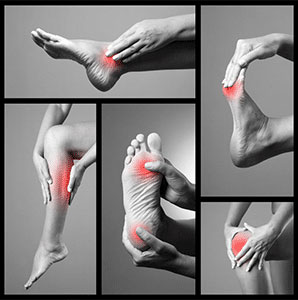
Most children who experience foot or leg pain are not able to express themselves or they don’t say anything and just deal with the pain, which leads to the pain going unnoticed. It’s important to have any problems checked out early and protect and support your child’s growing feet by providing your child with the correct pair of shoes. Let me show you the 5 most common signs that your child has a foot problem.
The Importance of Being Proactive!
Addressing your child’s foot conditions from an early stage can prevent future foot, knee, leg, back, and neck problems. I don’t recommend taking the “wait and see approach” since this can only lead to your child’s foot condition getting worse. Be proactive!
I have been contacted by several families who took their kids to their medical professional and were told that the child will most likely “outgrow the pain”. These parents contact me daily explaining to me how they are still concerned about it, and they want to know what steps they can take to either reduce the pain or completely eliminate it.
I have found that depending on the degree of your child’s foot condition, the correct pair of shoes and in certain cases orthotics might be all that your child needs to significantly reduce or fully eliminate the pain.
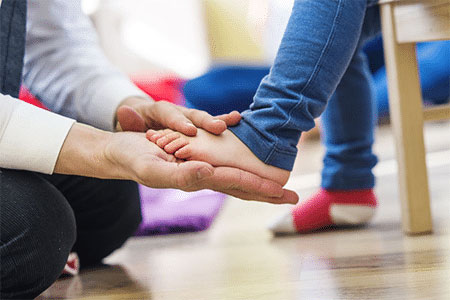
The 5 Most Commons Signs that Your Child Has a Foot Problem
I have put together the five most common signs that parents need to watch out for to prevent their kids’ foot issues from escalating. Ask yourself the questions below to figure out how to treat your child’s foot problems:
Number 1: Flat Feet
- Have you noticed your child walking or running differently?
- Does your child walk with his or her feet turning inwards?
- Is your child not able to keep up with his/her peers?
If you answer yes to any of those questions then it’s highly likely that your child has flat feet. When children have flat feet, their feet tend to collapse and roll inwards, which throws their whole body out of alignment.
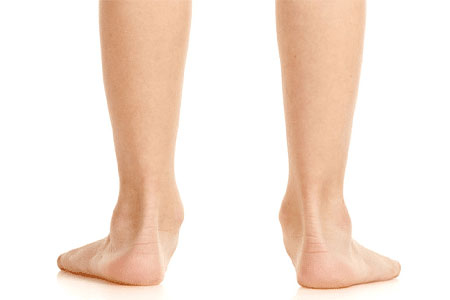
In most cases, the correct pair of shoes will help align your child’s feet and legs. I have written several articles that will help you identify whether your child is flat-footed or not and also show you a list of supportive everyday shoes for kids with flat feet.
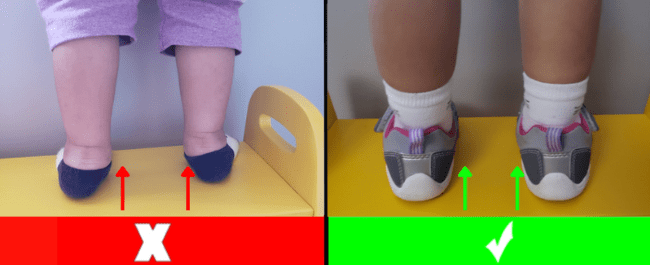
Number 2: Weak Ankles
- Are your children refusing to participate in activities that they used to enjoy?
- Does your child walk with his/her feet turning inwards?
If your children don’t want to participate in sports or high-impact activities that they used to enjoy before, they might be experiencing pain around the heel area. The repetitive stress from playing sports or performing high-impact activities can cause an inflammation of the growth plate, a weak area located at the back of the child’s heels.
Most children who deal with heel pain are between the ages of 8 and 14, but I have also seen cases where the heel pain started sooner. I have written several articles that describe the best heel cups and shoes for heel pain.
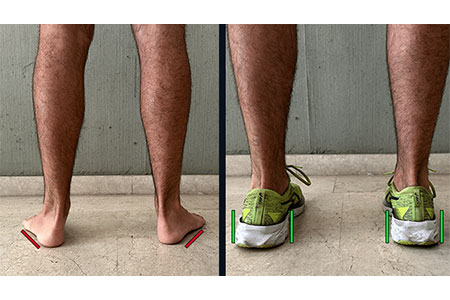
Number 3: Ingrown Toenails
- Is your child refusing to show you his/her feet?
- Is your child complaining about toe pain?
When children notice a change in the appearance of their feet or nails they might not say anything to their parents because they fear a trip to the doctor. I always recommend parents periodically inspect their children’s feet.

Shoes that are too short or too narrow are a direct cause of why children develop ingrown toenails. Deeper shoes that come with rounder toe-boxes are the most recommended ones if your child is dealing with an ingrown toenail.
If you believe your child might have an ingrown toenail, please take a look at an article that will help you identify whether your child has an ingrown toenail or not, and the best treatment to prevent this problem from reoccurring again.
Number 4: Stability Issues
- Are your children constantly tripping and falling?
When children keep falling it might be a sign that they have stability issues. Shoes that are too short or too long are a direct cause of why children fall. Children with stability issues can benefit from shoes that come with shoelaces instead of velcro closure, since shoelaces will hug your kids’ feet better and make them feel more stable.
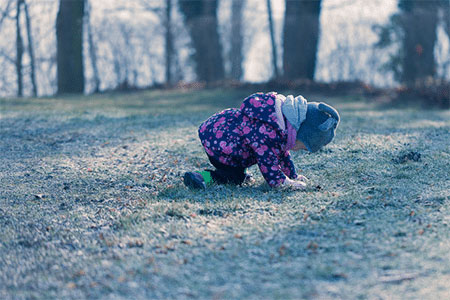
To make sure that your child is wearing the correct shoe size, I recommend taking your child to your local specialized children’s shoe store, where a shoe fitter can properly measure your child’s feet and find shoes that fit. If you don’t have a local shoe store, I created a virtual shoe fitting service that will help you retrieve your child’s shoe size from home.
Number 5: Toe Walking
- Are your children walking on their toes?
Toe-walking for children who are in the learning walking stage is common, but if you notice that your child continues to toe walk beyond the toddler years (by 3 years of age), then you must take action since it can lead to stiff muscles and make your child more prone to falling.
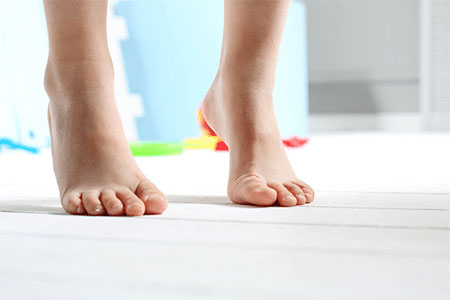
Certain shoes can help prevent your child from getting on his/her toes. These shoes are less flexible at the front and come with shoelaces instead of velcro closure. The article below will help you identify whether your child is walking on his/her toes or not, and the best anti-toe walking shoes to help “ground” your child.
I have helped you identify the 5 most common signs that your child might have a foot problem. Your next step requires you to be proactive, since the earlier you take action, the higher the chances that you can effectively treat your child’s foot condition.
Get in Touch for a Personalized Shoe Suggestion
Without a doubt, children’s shoe needs can vary depending on their age, activity level, and any specific foot conditions they may have. If you have any questions or need any further assistance, you can also contact me via email and I will get back to you as soon as possible. I am happy to help you find a different pair of shoes for your child so don’t hesitate to reach out if you have any questions.
Has your child been complaining about foot or leg pain? Does your child have a foot condition that I haven’t addressed? Please share your experiences below so other families can benefit from your experiences.

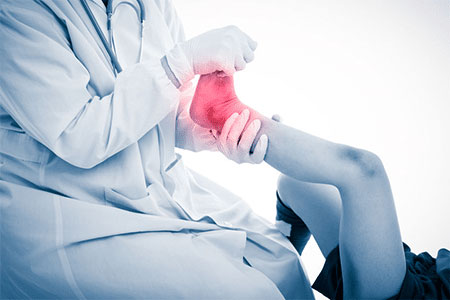
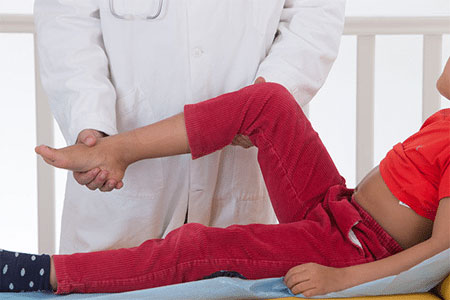
My brother and I recently visited a family member who had other house guests with toddler boys, aged 18 to 30 months. Two were brothers, and both had extremely divergent big toes on both feet. The children had not ever worn shoes, as their mothers insisted that children should not ever wear shoes, despite the extreme deformity of the toddlers’ feet. This deformity caused the children to teeter totter, often falling over & hitting their heads. My brother had mentioned that, if perhaps the children wore orthopaedic shoes, it might bring the big toes back into alignment, giving better stability to the feet, and stop the constant falls these children experienced whilst trying to walk. Why are mothers today so opposed to their children wearing shoes, even if there are foot deformities, or in the coldest of weather. I have seen older children crying in pain as their mothers insisted they walk barefoot on city pavements during freezing winter temperatures. I find this trend disturbing and perplexing, as under certain circumstances such as above, the children truly suffer. Also, what can be done to correct the extremely divergent big toe deformities these days? In the past, shoes corrected the problem. Thank you.
Hi Susan –
Thank you for sharing your experience. Some parents are hesitant to provide their toddlers with shoes because they believe that the shoes might hinder healthy foot development. This is what they believe in, and while I strongly disagree with this, I respect their choice. I believe that shoes play a key role in keeping children’s feet healthy. Most babies and toddler’s shoes now come with sensory pods in the bottom, which allows toddlers to sense the ground and allow healthy foot development.
Shoes can help children with stability issues and help improve their posture. There are certain shoe styles and orthotics that come with a toe rise that will help treat a big toe deformity. I believe those children could greatly benefit from wearing shoes and orthotics as well, depending on the degree of the big toe deformity.
Thank you agin for sharing.